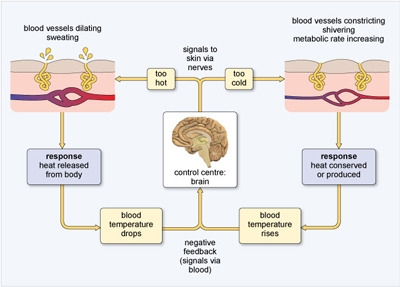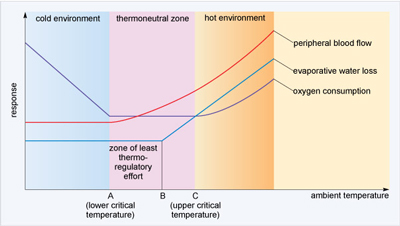4 Introduction to homeostasis
Organisms have the remarkable ability to regulate their internal environment, and maintain a favourable state even if the external environment changes. Normal functioning involves a self-regulating mechanism whereby any deviations from optimum conditions tend to cause responses that return the system to this state. The ability of an organism to regulate its internal environment is the result of a suite of physiological processes, called homeostasis. Homeostatic mechanisms regulate many different aspects of physiology, including temperature, concentrations of dissolved oxygen, carbon dioxide and sugar, osmotic pressure, redox potentials and pH.
The methods used to maintain body temperature can be divided broadly into two types. Animals that rely predominantly on internal metabolic processes as a source of heat energy generally maintain a stable body temperature that is precisely regulated. They are known as endotherms or homeotherms. Those animals that rely on external sources of heat energy may maintain a relatively stable and precisely regulated body temperature, as long as external heat energy is available, but will be unable to do so when it is absent. These ectotherms or poikilotherms are able to tolerate a substantial lowering of body temperature, which endotherms generally cannot. Birds and mammals are endotherms; all other animals are ectotherms, with a few species specific exceptions.
When ambient temperatures fall so low that heat loss to the environment threatens to lower body temperature, endotherms use several strategies to supplement and conserve body heat. Specialised nerve cells detect a drop in temperature and relay this information to the brain. Shivering is initiated in muscles, warming them and the blood flowing through them. This response is an example of negative feedback (Figure 19), where a control mechanism reacts to a change in the output of the system by initiating a restoring action. If the brain detects that body temperature is not optimal, then actions are triggered that will restore homeostasis.
Negative feedback systems maintain a preset state and so are stabilising - an important feature of homeostasis.

The amount of energy an organism uses in a unit of time is called its metabolic rate. Metabolic rate can be determined by the amount of oxygen consumed or carbon dioxide produced by cellular respiration. Organisms must maintain a minimum metabolic rate for basic functions such as cell maintenance, repair and internal transport. The minimum metabolic rate of a homeotherm is known as the basal metabolic rate (BMR).
Basal metabolic rate is measured under a temperature range that does not require the generation or shedding of heat above the minimum. In other words, it does not involve thermoregulation because external temperatures do not diverge from comfortable limits. The range of temperatures over which BMR is maintained comprise the thermoneutral zone (Figure 20). When external temperatures exceed or drop below those within the thermoneutral zone, physiological changes such as those initiated by shivering or sweating are deployed to maintain body temperature within the thermoneutral zone.
However, thermoregulation causes an increase in BMR and this increase in BMR sets the limit of what temperatures can be tolerated beyond the thermoneutral zone. When ambient temperatures fall below the thermoneutral zone (lower critical temperature), heat production must increase and/or heat loss must decrease. Above the thermoneutral zone (upper critical temperature), heat loss must increase and must also cope with the rise in BMR that is a consequence of rising body temperature. Maintaining a constant temperature therefore makes a constant demand on either the biochemical processes of heat production and/or the physical mechanisms for heat loss. Figure 20 illustrates the effect of rising ambient temperature on BMR, shown as oxygen consumption, and heat loss which is a combination of evaporative water loss and peripheral blood flow changes, i.e. dilation.

In the thermoneutral zone, what happens to BMR?
It stays constant at a low level. Therefore thermoregulation is achieved at minimal metabolic cost in the thermoneutral zone.
Thermoregulation is critical for survival because most biochemical and physiological processes are sensitive to changes in temperature. For every 10 °C decrease in temperature the rates of most enzyme-mediated reactions decrease two- to threefold. A substantial decrease in temperature (hypothermia) can result in such a decrease in overall metabolic rate that it causes a breakdown in normal cellular function and eventually death. Increase in temperature (hyperthermia) conversely speeds up reactions and causes an increase in metabolic rate. It may also cause proteins (including, of course, enzymes) to become less active through denaturation of their structure.
Rüppell's fox is nocturnal. During the day when the ambient temperature is around 40 °C the fox rests inside the underground den. At night the fox emerges and forages for reptiles and insects. What advantage does the nocturnal life style offer the fox?
Resting in the den during the day avoids the need for physiological thermoregulation such as panting. At night the ambient temperature is much lower. By emerging to hunt at night the fox reduces the need for evaporative water loss and minimises energy consumption for thermoregulation.
